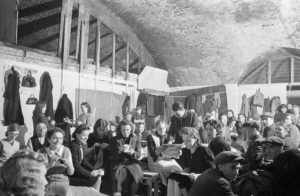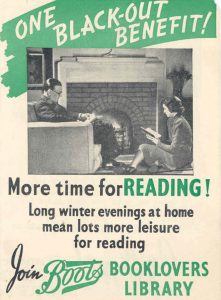As people remain confined to their homes, options for what we do with our free leisure time has become restricted. Associate Professor Nicola Wilson from the School of Literature and Languages explores popular reading choices during the second world war and what this tells about how we get through a crisis in a recent post for The Conversation.

These are unprecedented times – but, even so, comparisons are being made to the second world war in terms of the magnitude of the crisis that coronavirus represents. Some of this rhetoric is unhelpful but, as we bunker down into our homes and the government gets on a war footing, there is little doubt that the challenge to our liberty, leisure time and sense of wellbeing is real.
With early reports that book sales are soaring while bookshops and warehouses close down and publishers reassess their lists, what can the reading patterns of an earlier generation tell us about getting through a crisis and staying at home?
The restrictions at the beginning of the second world war affected all aspects of day-to-day life. But it was the blackout that topped most people’s list of grievances – above shortages of food and fuel, the evacuation, and lack of news and public services. Households were reprimanded and fined for showing chinks of light through windows, car lights were dimmed, and walking around, even along familiar streets, late at night became treacherous.
With the widespread limitations to free movement, the book trade was quick off the mark. Books were promoted by libraries and book clubs as the very thing to fight boredom and fill blacked-out evenings at home or in shelters with pleasure and forgetfulness. “Books may become more necessary than gas-masks,” the Book Society, Britain’s first celebrity book club, advised.
Selling tales
I’ve been researching the choices and recommendations of the Book Society for the past few years. The club was set up in 1929 and ran until the 1960s, shipping “carefully” selected books out to thousands of readers each month. It was modelled on the success of the American Book-of-the-Month club (which launched in 1926) and aimed to boost book sales at a time when buying books wasn’t common. It irritated some critics and booksellers who accused it of “dumbing down” and giving an unfair advantage to some books over others – but was hugely popular with readers.

The Book Society was run by a selection committee of literary celebrities – the likes of JB Priestley, Sylvia Lynd, George Gordon, Edmund Blunden and Cecil Day-Lewis – chaired by bestselling novelist Hugh Walpole. Selections were not meant to be the “best” of anything, but had to be worthwhile and deserving of people’s time and hard-earned cash.
Guaranteeing tens of thousands of extra sales, the club had a huge impact on the mid-20th-century book trade, with publishers desperate to get the increased sales and global reach of what publisher Harold Raymond called “the Book Society bun”.
Books will go on
The Book Society guided readers through the confusion of appeasement and the run-up to the second world war with a marked increase in recommendations of political non-fiction examining contemporary geo-politics. The classic novel of appeasement was Elizabeth Bowen’s The Death of the Heart (Book Society Choice in October 1938) in which a sense of malaise and inevitability of future war haunts the characters’ desperate actions.
When Britain finally declared war against Germany in September 1939, the Book Society judges were divided. Some were relieved that, as George Gordon put it, “an intolerable situation has at last acquired the awful explicitness of war”. But others were devastated, especially Edmund Blunden who was still traumatised from fighting in the first world war.
The judges advised members that when they became weary of news, people “will turn to books as the best comfort”, as had happened in the first world war with the increase in reading and library membership. Publishers and booksellers faced huge challenges during the second world war, including paper shortages, problems in distribution, a vanishing workforce, and bomb damage to offices and warehouses. But there were more readers – and from a wider social class – at the end of it. Demand consistently outstripped supply as consumer expenditure on books more than doubled between 1938 and 1945.
What people were reading
Throughout the second world war, the Book Society varied its lists between books that offered some insight on the strangeness of contemporary life and works of fiction – especially historical fiction – that took readers’ minds off it.
Titles in the first group include comic novels by the likes of E M Delafield and Evelyn Waugh, as well as forgotten bestsellers like Ethel Vance’s Escape (1939) (an unlikely thriller set in a concentration camp) and Reaching for the Stars (1939), American journalist Nora Waln’s inside account of life in Nazi Germany.
More topical non-fiction became a priority as the devastation of the Blitz kicked in. Winged Words: Our Airmen Speak for Themselves (1941) and Into Battle: Winston Churchill’s War Speeches (1941) were especially popular.
Historical fiction was consistently in demand. Half the club’s choices in 1941 were long novels with historical settings. As today’s readers prepare to batten down the hatches with Hilary Mantel’s 900-page latest book, it is sobering to reflect on how an imaginative connection with the past has long helped readers find relief from the madness of the present.
The other fail-safes in the second world war were the classics. As books already in print became scarce, the Book Society reissued new editions of Jane Austen’s Pride and Prejudice, and Tolstoy’s War and Peace and Anna Karenina. These were books that Walpole said he believed he could sit down with even through an air raid.
Indeed, Neilsen BookScan has reported a rise in sales of classic fiction as the coronavirus crisis deepens – including War and Peace – as readers use this unfamiliar time to knuckle down to the heavyweights.
You can also join a War and Peace reading group online if you want a bit of company. After the homeschooling, working from home, and everything else. Here goes.
